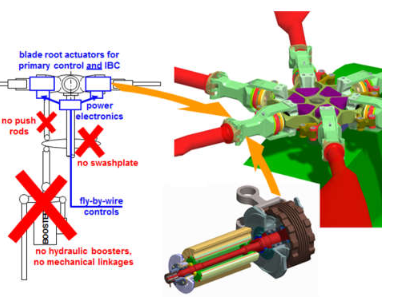Yes that is possible and has been attempted by the german company Airbus Helicopter Technik GmbH (formerly called ZF Luftfahrttechnik GmbH) in cooperation with Sikorsky. They have published two papers (here and here).

The resulting rotor is quite a beast; note that the silver dome in the picture below houses all of the power electronics, which emit quite a bit of heat.

The advantages of installing this system are coupled to the IBC (Individual Blade Control) concept. Hereby, one can actuate each blade individually. This brings a couple of possible benefits
- Reduction of noise, as one can prepitch the blade before beating through another vortex
- Reduction of vibrations, by actively countering these (which is why this setup is interesting for Sikorsky)
- Lower main rotor power demand, as less energy is wasted
- (However not all of these benefits can be achieved simultaneously)
Obviously the system is quite complex, you need a lot of electronic hardware to manage the powerflow and this hardware has to be mounted on the rotorsystem. Especially interesting is the fact that the actuators are able to regenerate power as the blade is back-driven in some portions of its revolution. Distributing this power to the other actuators is a demanding task from an electronic point of view (something which a swashplate does for free).

But the gains might outweight this drawback especially for rigid rotor systems such as the Sikorsky X2 rotorsystem, as these rotors are naturally very prone to vibrations.
The authors claim that this system has been successfully tested on a teststand, but not yet in real-life. However, from personal experience I can say that the prototype is quite impressive.



